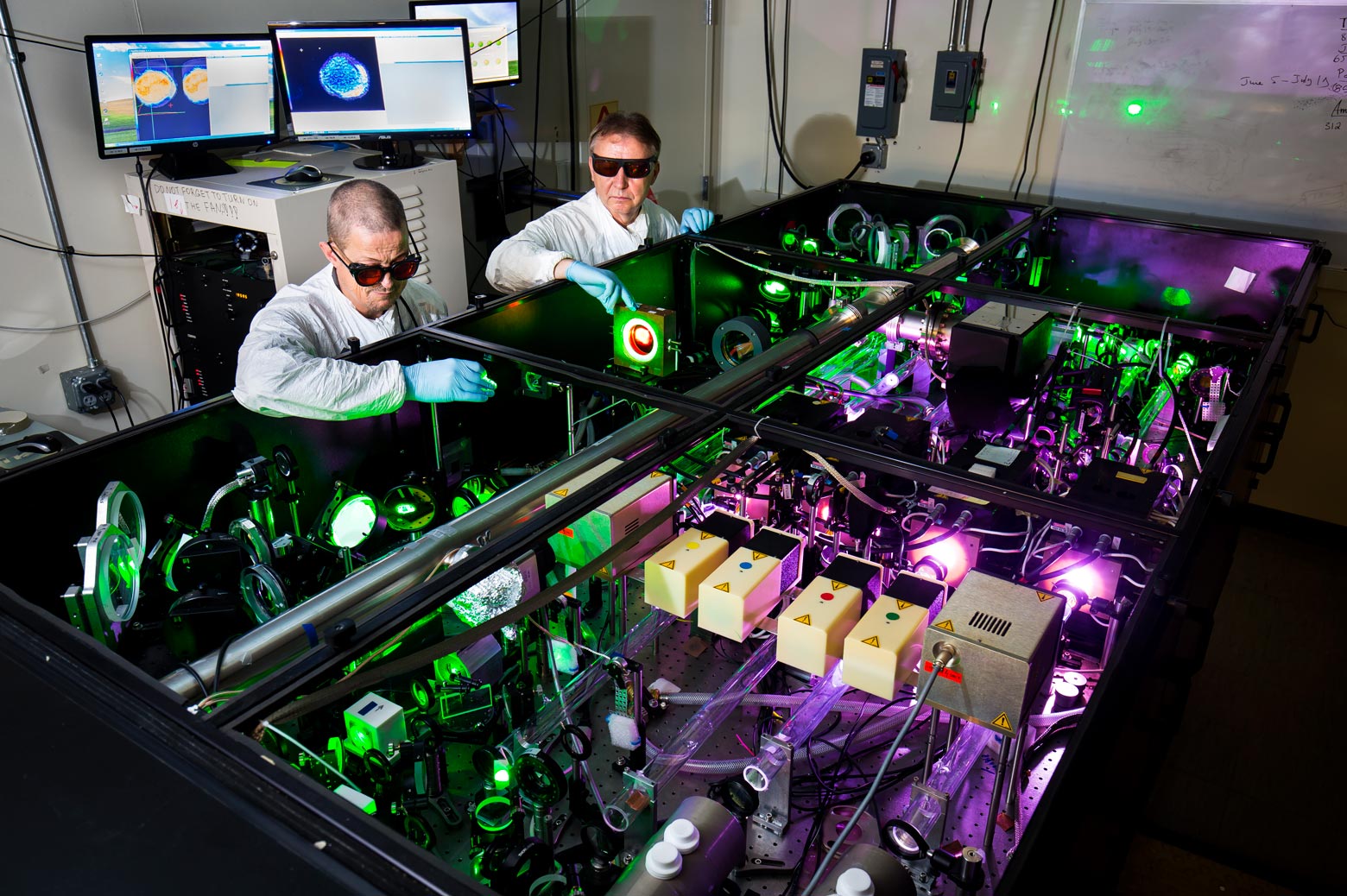Doubling the power of the world’s most intense laser
It could enable tabletop particle and X-ray sources as well as the investigation of astrophysics and quantum dynamics.

 Enlarge
Enlarge
The most intense laser in the world is about to get a power upgrade with $2 million from the National Science Foundation.
With more laser energy to focus, researchers at the University of Michigan and collaborators from around the world can make better tabletop devices that produce particle and X-ray beams for medical and national security applications – and also explore mysteries in astrophysics and the quantum realm.
The power of the HERCULES laser pulses comes from a series of five embedded “pump” lasers that amplify ultrashort pulses of light. To upgrade the power of HERCULES from 300 trillion watts, or terawatts (TW), to 500 or even 1,000 TW, the researchers will replace the final three of those pump lasers.
If HERCULES can achieve 1,000 TW, it would once again be among the most powerful lasers in the US. Regardless, the bump in power will up the ante on its intensity record – currently 20 sextillion (2×1022) watts per centimeter squared. The improved HERCULES should be able to double or even triple that.
A decade ago, when engineers at Michigan first built HERCULES, the commercial pump lasers the system relies on couldn’t reach the ambitious 300 TW – record-breaking at the time – that the researchers had in mind. They had to build their own pump lasers. Now, driven by a demand from international projects seeking power levels north of 10,000 TW, commercial pump lasers can outstrip the home-made versions that run in HERCULES today. This new technology will push HERCULES to higher power and intensity than ever before.
It also opens up a new regime at the very frontier of plasma physics, where quantum phenomena start to play an important role.
Karl Krushelnick
“This upgrade enables a wide variety of different experiments,” said Karl Krushelnick, a professor of nuclear engineering and radiological science and director of the Center for Ultrafast Optical Science, which houses HERCULES.
“There are these exciting applications, and it also opens up a new regime at the very frontier of plasma physics, where quantum phenomena start to play an important role.”
This is what researchers have to look forward to:
- Tabletop accelerators
Conventional particle accelerators are often hundreds of yards long, but laser light can power the acceleration of particles and produce other high-energy beams such as X-rays in just a few square yards or less. In the future, laser-driven particle accelerators may help reveal new physics or to drive ultra-compact X-ray lasers. Particle and X-ray beams can also be used to determine the presence of nuclear materials in shipping containers coming into ports, for instance. They are used for medical treatments such as radiation therapy as well. - X-rays that differentiate among soft tissues
High-energy X-ray beams emitted by laser accelerators could enable advanced X-ray imaging that can find the boundaries between soft tissues – as opposed to conventional X-rays, which are best at picking out dense materials like bone. When the X-rays from a laser accelerator travel through different materials, their waves get out of sync to different degrees, and this can distinguish between a lung and a heart, for example. This method of measuring would be cheaper and offer faster results than an MRI. - Gamma ray bursts: astrophysical mysteries
How are flares of powerful electromagnetic radiation that last for no longer than a few seconds produced in space? One theory holds that very strong magnetic fields, near black holes for instance, may be breaking apart. When the magnetic field lines come back together, or reconnect, they can accelerate particles that release these powerful bursts of electromagnetic energy in the form of gamma rays. By using the HERCULES laser in the lab, the CUOS team can create strong magnetic fields on microscopic scales that can break apart and reconnect in the same way, shedding light on whether this is really the mechanism behind gamma ray bursts. - Questions in strong field quantum electrodynamics
Quantum electrodynamics – the quantum description of light and its interactions with matter – hasn’t been adequately tested in some extreme situations. For example, when electric fields are strong enough, the phenomenon of “boiling the vacuum” is predicted occur – matter and antimatter can spontaneously appear from nothing. Electric fields this strong may be found in neutron star atmospheres, for example. The upgraded HERCULES laser can simulate these environments by accelerating electrons to near the speed of light, so that – from the vantage point of the electrons – the fields in the lab are strong enough to generate particles from the vacuum. By looking at how the electrons behave, researchers can deduce whether the predictions of quantum electrodynamics are accurate.
Krushelnick anticipates that the expanded capabilities of HERCULES will enable researchers at U-M who specialize in these areas to do experiments that were previously impossible. In addition, HERCULES powers experiments for researchers around the US and abroad, so the upgrade will make it more valuable as a national scientific resource.
Krushelnick is also a professor of electrical engineering and computer science and of physics.
In the Media
A stellar achievement: Magnetized space winds in the laboratory
The international team that includes Prof. Louise Willingale is investigating the role of intense magnetic fields dragged by high-speed plasmas through astrophysical environments. HERCULES was used in the experiments.